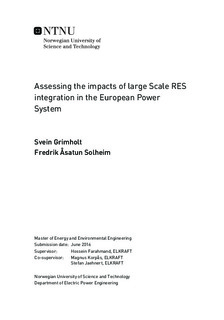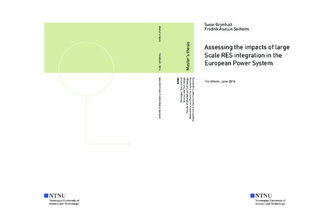| dc.description.abstract | This Master s thesis is a part of the course TET4915. It highlights the consequences of increasing the amounts of intermittent renewable energy sources (I-RES) in the European power system. Simulations were carried out using the EMPS model and data sets were created based on future scenarios given by ENTSO-E. Three cases were established Scenario 1 (S1), 2 (S2) and 3 (S3). The scenarios differ based on several attributes, however the main difference is installed I-RES capacity (with capacity increasing going from S1 to S3).
The analyses investigates how central attributes such as generation mix, prices, transmissions and asset profitability change between the different scenarios.
As I-RES capacity increases, thermal generation is substituted with renewable production. The RES penetration is 39, 57 and 78 % for S1, S2 and S3 respect-ively. As a result, fossil and nuclear generation is reduced by 66 and 30 % in S3 compared to S1. Combined with low utilization, the results indicate that there s a fair amount of excess thermal power in the system.
Large scale integration of I-RES causes a drop in power prices. Due to changes in fuel- and CO2 prices, the average power price is fairly similar in S1 (106.3 /MW) and S2 (105.3 /MW). In S3, however, the average price plummets to 45.3 /MW, a 57 % reduction compared to S2.
Transmission lines have increased utilization as the amount of I-RES increases. Very high congestion rates are found for a considerable amount of lines in the system. In S2 and S3, several of the Norwegian lines approach 100 % utilization. The results indicate that certain lines will need to be reinforced in a system where I-RES constitutes a large share of the power production.
The drop in power prices highly affects the profitability of power plants. In a high-RES system such as S3, no assets apart from bio power is profitable. This includes both thermal and renewable assets. Thus, there would be no incentives for investments apart from bio power. This indicates that some form of capacity remuneration mechanisms would need to be deployed for such a system composition to work. Looking at S3, a total of 41 and 175 billion Euros would have to be supported for thermal and RES assets respectively.
For transmission lines the trend is reversed. As price differences are increased going from S1 to S3, so is line profitability. Transmission lines are the most profitable assets in the system by far, incentivizing additional line investments.
An investment analysis performed on S3 resulted in three modified scenarios S3.1, S3.2 and S3.3. These featured around 50 % reduction in fossil capacity as well as varying capacity increases on certain transmission lines.
Increased lines leads to reduced line utilization for the respective lines as well as lower average prices. The reduction in fossil capacity leads to increased profitability. While still unprofitable, the total support required from thermal assets is now 13, 20 and 23 billion Euros for S3.1, S3.2 and S3.3 respectively. These are large reductions compared to the 41 billion Euros seen in S3.
129 TWh of dump energy is present in S3. Increasing lines contribute to reducing this number, with 115, 110 and 112 TWh being present in S3.1, S3.2 and S3.3 respectively. Examining a scenario with unlimited transmission capacity, 92 TWh is still present in the system. Thus, the installed I-RES capacity is so large that energy production exceeds demand. This clearly shows the need for grid energy storage in high-RES power systems. | |

